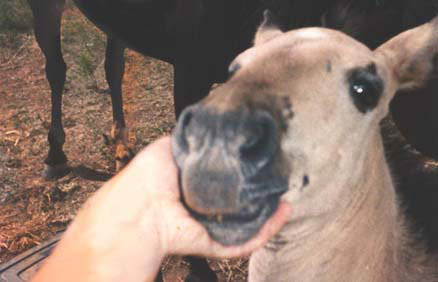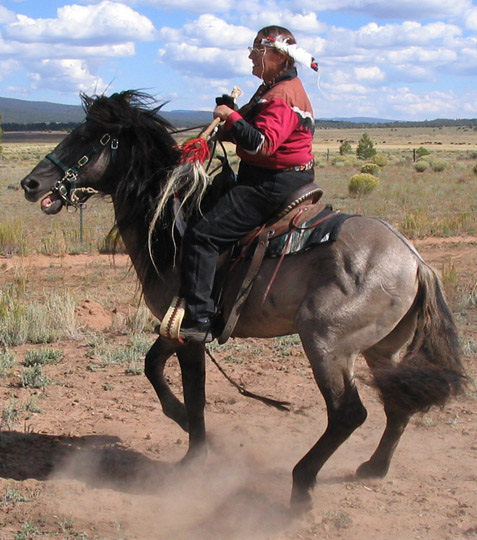Breeding for the dilute colors can be chancy. The problem
is that every horse carries two alleles (variations on a gene)
for each color gene. Scientists have discovered alleles of four genes that can create dilute colors: dun, cremello, champagne
and silver dapple. The actions of these alleles are not always
simple. Sometimes you can tell what colors a horse could throw
just by looking. More often, these alleles may mask other colors
that can put in surprise appearances in a horse's offspring.
However, if you know what to look for, and take advantage
of genetic testing, you can increase your success rate when breeding
for dilute colors.
Duns and Buckskins
Duns and buckskins have a dilute body color with darker points.
They usually owe their colors to the effects of the dun or cremello
alleles, and to background colors thrown by the black, bay or
chestnut alleles.
Lineback Dun
Scientists believe that lineback dun on a bay background (zebra
dun) is the natural color of the ancestors of today's horses.
Lineback duns all carry one or two copies of the dun allele.
Dun dilutes the background color of a horse's body while leaving
the mane, tail, and points dark. Thus, dun paired with black
causes a horse to be blue or slate with black mane and tail (grullo).
Against a bay background, red is faded to tan or gold, leaving
a black mane and tail (lineback buckskin). On a sorrel (chestnut)
background, red is faded to pale red with darker red mane and
tail (red or apricot dun).
All horses with the dun allele have a dark stripe down the
back (lineback or eel stripe). Many also have stripes on their
shoulders and legs. Some also show dark webbing on the head.
In the extreme expression, these "primitive marks"
are almost as extensive as on a zebra. Scientists do not understand
the genetic mechanism(s) controlling the extent of primitive
marks.
The dun allele is dominant. That means that a heterozygous
(one copy of the allele) dun looks the same as a homozygous dun
(two copies of the allele). This is important because if you
breed heterozygous duns to each other, you have only a 75% chance
of getting a dun foal. If one is homozygous, you have a 100%
chance.
There is no genetic test for homozygous dun.
More --->>

Lineback buckskin foal. Note the stripes under his chin
and his facial markings. This is an extreme example of the primitive
markings that often occur with lineback duns.

|
Above, Rowdy Yates, a lineback grullo dun, ridden by his owner,
Vickie Ives. This Spanish Mustang stallion was the model for
the Rowdy Yates Breyer horse, produced 2002-2005. His personality, strength and endurance
were the model for the starring horse of the movie Spirit: Stallion
of the Cimarron.
You can learn more about Rowdy Yates, Vickie Ives, and
her Karma Farms at http://www.karmafarms.com. |

